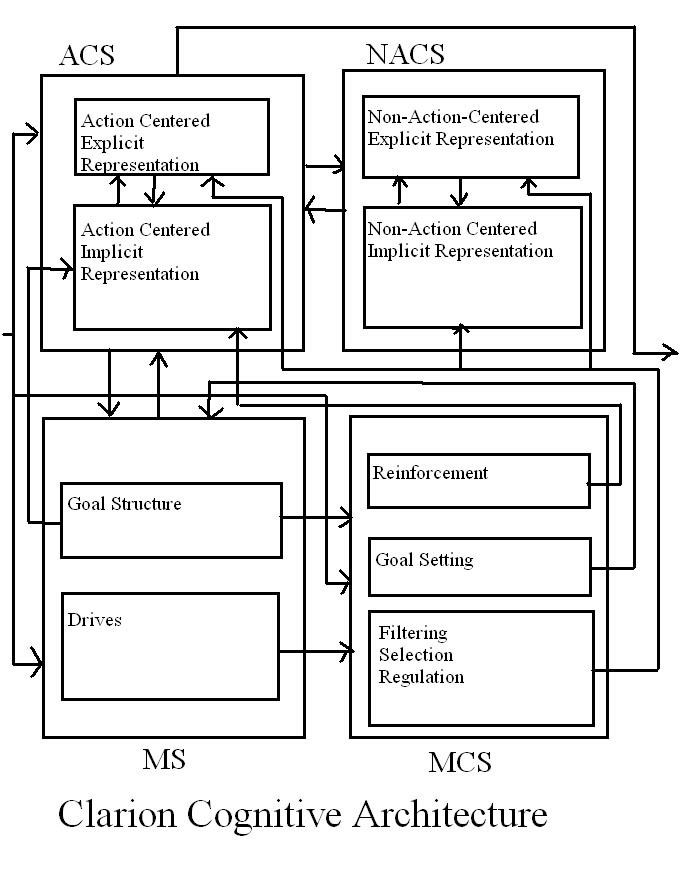 | ||
Connectionist Learning with Adaptive Rule Induction On-line (CLARION) is a cognitive architecture that has been used to simulate several tasks in cognitive psychology and social psychology, as well as implementing intelligent systems in artificial intelligence applications. An important feature of CLARION is the distinction between implicit and explicit processes and focusing on capturing the interaction between these two types of processes. The system was created by the research group led by Ron Sun.
Contents
Overview
CLARION is an integrative architecture, consisting of a number of distinct subsystems, with a dual representational structure in each subsystem (implicit versus explicit representations). Its subsystems include the action-centered subsystem, the non-action-centered subsystem, the motivational subsystem, and the meta-cognitive subsystem.
Action-centered subsystem
The role of the action-centered subsystem is to control both external and internal actions. The implicit layer is made of neural networks called Action Neural Networks, while the explicit layer has is made up of action rules. There can be synergy between the two layers, for example learning a skill can be expedited when the agent has to make explicit rules for the procedure at hand. It has been argued that implicit knowledge alone cannot optimize as well as the combination of both explicit and implicit.
Non-action-centered subsystem
The role of the non-action-centered subsystem is to maintain general knowledge. The implicit layer is made of Associative Neural Networks, while the bottom layer is associative rules. Knowledge is further divided into semantic and episodic, where semantic is generalized knowledge, and episodic is knowledge applicable to more specific situations. It is also important to note since there is an implicit layer, that not all declarative knowledge has to be explicit.
Motivational subsystem
The role of the motivational subsystem is to provide underlying motivations for perception, action, and cognition.The motivational system in CLARION is made up of drives on the bottom level, and each drive can have varying strengths. There are low level drives, and also high level drives aimed at keeping an agent sustained, purposeful, focused, and adaptive. The explicit layer of the motivational system is composed of goals. explicit goals are used because they are more stable than implicit motivational states. the CLARION framework views that human motivational processes are highly complex and can't be represented through just explicit representation.
Example of some low level drives:
Example of some high level drives:
there is also a possibility for derived drives (usually from trying to satisfy primary drives) that can be created by either conditioning, or through external instructions. each drive needed will have a proportional strength, opportunity will also be taken into account
Meta-cognitive subsystem
The role of the meta-cognitive subsystem is to monitor, direct, and modify the operations of all the other subsystems. Actions in the meta-cognitive subsystem include: setting goals for the action-centred subsystem, setting parameters for the action and non-action subsystems, and changing an on-going process in both the action and non-action subsystems.
Learning
Learning can be represented with both explicit and implicit knowledge individually while also representing bottom-up and top-down learning. Learning with implicit knowledge is represented through Q-learning, while learning with just explicit knowledge is represented with one-shot learning such as hypothesis testing. Bottom-up learning is represented through a neural network propagating up to the explicit layer through the Rule-Extraction-Refinement algorithm (RER), while top-down learning can be represented through a variety of ways.
Comparison with other cognitive architectures
Theoretical applications
CLARION has been used to account for a variety of psychological data, such as the serial reaction time task, the artificial grammar learning task, the process control task, a categorical inference task, an alphabetical arithmetic task, and the Tower of Hanoi task. The serial reaction time and process control tasks are typical implicit learning tasks (mainly involving implicit reactive routines), while the Tower of Hanoi and alphabetic arithmetic are high-level cognitive skill acquisition tasks (with a significant presence of explicit processes). In addition, extensive work has been done on a complex minefield navigation task, which involves complex sequential decision-making. Work on organizational decision tasks, and other social simulation tasks, as well as meta-cognitive tasks, has also been initiated.
Other applications of the cognitive architecture include simulation of creativity and addressing the computational basis of consciousness (or artificial consciousness).
